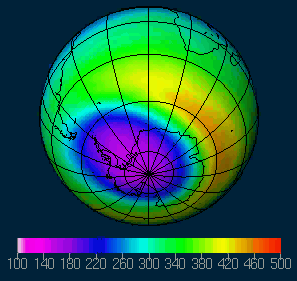This image shows the amount of ozone in Earth's stratosphere. The colors represent different amounts of ozone with purple and blue indicating very low levels of stratospheric ozone. Yellow and green represent higher levels of ozone. Notice the blue and purple spot over the South Pole which is the Antarctic ozone hole. The ozone levels are monitored by satellite.
Click on image for full size
Courtesy of NASA
Repairing the Antarctic Ozone Hole!
News story originally written on September 17, 2002
The ozone layer in the stratosphere is important for life on Earth because it shields the Earth from the Sun’s harmful rays. Scientists have been watching a hole grow in the ozone layer above the South Pole for years, but now they have some good news. They say that the Antarctic ozone hole may close by 2050!
The ozone hole over Antarctica formed mainly because Chlorofluorocarbons (CFCs) were destroying ozone. CFCs are made by humans and released into the atmosphere when refrigerators and air conditioners run. CFCs in the atmosphere are able to break ozone apart when a chlorine atom from a CFC molecule, broken off by UV radiation, attacks an ozone molecule.
It looks like our efforts to cut down on activities that release CFCs are making a difference according to a recent study that says the amount of CFCs in our atmosphere has been declining since 2000. “We are now at a point where the atmosphere can actually remove CFCs faster than they are being released into the atmosphere,” said Paul Fraser, a scientists and one of the authors of the report.
Last modified September 17, 2002 by Lisa Gardiner.
You might also be interested in:

It was another exciting and frustrating year for the space science program. It seemed that every step forward led to one backwards. Either way, NASA led the way to a great century of discovery. Unfortunately,
...more
The Space Shuttle Discovery lifted off from Kennedy Space Center on October 29th at 2:19 p.m. EST. The weather was great as Discovery took 8 1/2 minutes to reach orbit. This was the United States' 123rd
...more
A moon was discovered orbiting the asteroid, Eugenia. This is only the second time in history that a satellite has been seen circling an asteroid. A special mirror allowed scientists to find the moon
...more
Will Russia ever put the service module for the International Space Station in space? NASA officials want an answer from the Russian government. The necessary service module is currently waiting to be
...more
A coronal mass ejection (CME) happened on the Sun early last month. The material that was thrown out from this explosion passed the ACE spacecraft. The SWICS instrument on ACE has produced a new and very
...more
J.S. Maini of the Canadian Forest Service called forests the "heart and lungs of the world." This is because forests filter air and water pollution, absorb carbon dioxide, release oxygen, and maintain
...more
In late April through mid-May 2002, all five naked-eye planets are visible at the same time in the night sky! This is includes Mercury which is generally very hard to see. You won't want to miss this!
...more















